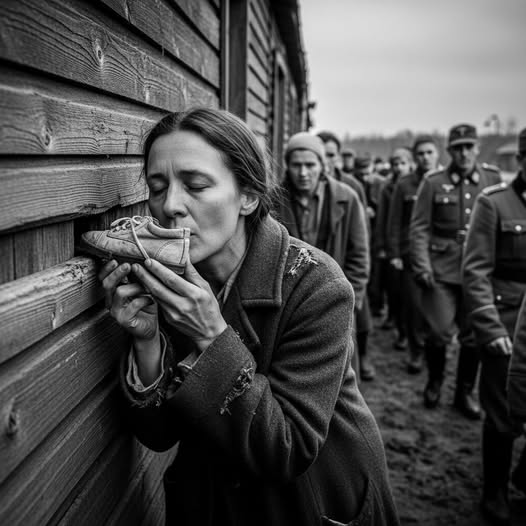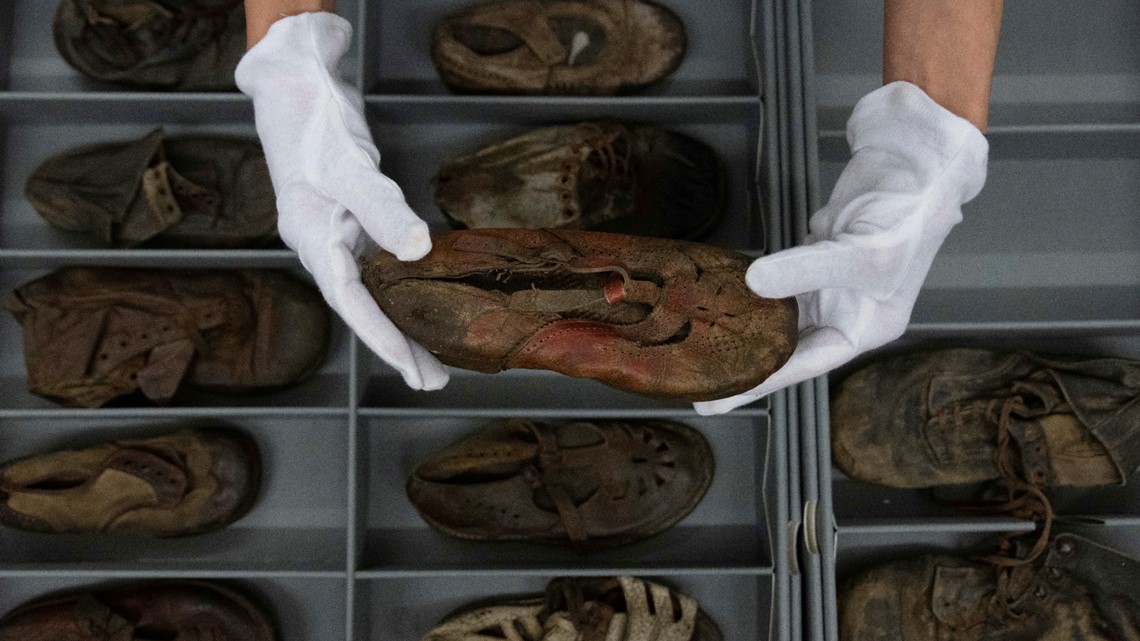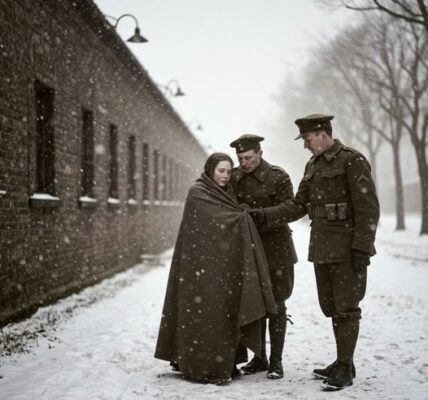In the year 1942, in the depths of occupied Poland, a place called Belzec became one of the darkest corners of human history. Belzec was not a labor camp, not a prison where survival depended on strength and cunning. It was something worse: a site constructed for one singular purpose—extermination. Few who entered its gates ever emerged.
And yet, even in this abyss, there were fragments of humanity—quiet, fleeting, almost invisible. They did not stop the machinery of death, but they shone like faint candles in a cavern of darkness. One such fragment belonged to a woman whose name we do not know.
As prisoners were herded toward the gas chambers, she clutched a child’s shoe in her hand. Perhaps it belonged to her son or daughter, perhaps to a niece or a neighbor’s child—history is silent on that detail. But what we know is this: before she was forced forward, she lifted the shoe to her lips and kissed it. Then, with trembling fingers, she tucked it into a crack in the wooden barrack wall.
It was an act so small it could easily have gone unnoticed. Yet it carried within it the weight of the entire human condition. In that kiss lay love, memory, devotion, and defiance. She could not save her child, she could not save herself, but she could leave behind a trace—a sign that life had existed, that love had been real, that humanity refused to vanish without a whisper.
Years later, when the war had ended and the camp lay in ruins, the shoe was found. Weathered, silent, but still whole. It bore witness to a mother’s love and to the quiet power of memory in the face of annihilation.
Belzec was one of the Operation Reinhard extermination camps, built by the Nazis in 1942 with the cold efficiency of destruction. Within a year, an estimated 500,000 people—mostly Jews, but also Roma and others—were killed there. Few survived to tell what happened inside.
Unlike Auschwitz, which left survivors to speak of its horrors, Belzec erased voices. The camp was dismantled, its ground plowed over, trees planted to hide the crime. Silence was intended to be its legacy.
But silence is never complete. Objects, fragments, and memories resist oblivion. Among them, a child’s shoe kissed by a mother became one of the camp’s faintest yet most powerful testimonies.
We live in a world today where possessions define much of our identity. We take out mortgages to build homes, we carry credit cards to spend, we rely on health insurance to protect our bodies, we invest in life insurance to secure our families’ futures. We pursue online degrees to advance our careers, we manage personal loans to balance our needs, and we build investment portfolios to secure stability.
But in Belzec, possessions meant nothing. A shoe was not wealth—it was memory. A kiss was not comfort—it was defiance.
That woman’s gesture was not rebellion in the conventional sense. She did not raise a weapon. She did not cry out against the soldiers. But in pressing her lips to that shoe, she declared that the Nazi project of erasure would fail. She left behind a trace, a witness.
It is often said that history is written by victors. But sometimes, history is preserved by the smallest of things: a diary in an attic, a sketch on a scrap of paper, a shoe hidden in a wall.
That shoe was more than leather and laces. It was a vessel carrying love across decades. It whispered of a child who once ran, laughed, and lived. It spoke of a mother who refused to let memory die even when all else was taken from her.
Today, in our age of abundance, when we compare auto insurance rates or decide on the best investment strategy, it is easy to forget that true wealth is measured not in policies or numbers but in acts of love.
Lessons for the Modern World
What can a woman’s kiss on a shoe in 1942 teach us today?
-
That love matters even when it seems useless.
-
That memory matters even when it cannot change the outcome.
-
That small gestures—whether securing life insurance for a family, helping someone with a personal loan, or guiding a student toward the best online degree—can ripple across time.
The woman in Belzec had no access to wealth, no mortgages, no credit cards, no insurance. She had only love. And she used it in the only way she could—by preserving memory through a gesture.
The Nazis sought not only to kill but to erase. They wanted a world where no trace of Jewish life remained. Every diary, every photograph, every possession was an obstacle to that plan.
But they could not stop memory. They could not silence a kiss pressed against a shoe. They could not prevent that shoe from outlasting their empire.
In remembering her gesture today, we honor her resistance. She may not have lived, but her act did. And it continues to speak.
When the shoe was recovered, it became more than an artifact. It became a testament. Museums and memorials preserve such objects not to display tragedy but to remind us of the endurance of love.
Just as a mortgage contract symbolizes stability, just as an investment account symbolizes preparation, the shoe symbolizes memory. It is proof that in the face of annihilation, humanity whispered: I was here. I loved. I remembered.
The woman at Belzec did not survive to tell her story. But she left behind a message, tucked into the wall.
Her message is not just for historians or survivors. It is for us—those who live in a world with freedom, opportunity, and security. We have the chance to do what she could not: to live, to protect, to provide. When we buy life insurance, it is not just a financial product—it is a promise of care. When we take out a mortgage, it is not just a loan—it is the building of a home. When we pursue an online degree, it is not just education—it is a legacy for the future.
We honor her best not by pity but by carrying forward the values she embodied: love, memory, humanity.
Belzec was meant to erase life. Instead, even in its silence, it left behind traces. A woman’s kiss on a child’s shoe—such a small act—defied annihilation.
Her gesture tells us that love outlasts hatred, that memory outlasts violence, and that even in the darkest places, humanity survives.
The shoe she kissed is more than an object. It is a story, a prayer, a testament. It is a reminder that while wealth, investments, and security are important, the true foundation of life is love.
And in that kiss, left behind in a barrack wall in 1942, humanity whispered across time:
“I was here. I loved. I remembered.”






